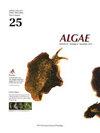stirisquamtum Amphitinium sp.nov.(藻科),一种新的生活在沙中的甲藻,具有一种新型的鳞片
IF 2.4
3区 生物学
Q1 MARINE & FRESHWATER BIOLOGY
引用次数: 4
摘要
两栖类是海洋潮间带沙质生态系统中最丰富的底栖甲藻之一。它们中的一些产生了各种生物活性化合物,既有有害作用,也有药用潜力。在本研究中,从东海潮间带的沙子中分离到了两栖类细胞。对建立的两个菌株进行了详细的光照、扫描和透射电子显微镜检查。营养细胞有一个微小的、不规则的、三角形的上颚向左偏转,因此符合狭义安菲藻的描述。这些菌株与其他两栖类物种的组合特征不同:(1)纵向鞭毛插入细胞的下三分之一;(2) 细胞表面有冰柱状鳞片,长276±17nm;(3) 不对称的下视轴,左侧比右侧长;和(4)不动细胞的存在。因此,它们在这里被描述为Amphitinium stirisquamtum sp.nov。根据小亚基rRNA、大亚基rNA和内部转录空间5.8S序列推断的分子树表明,A.stirisquartum与Amphitinium,但与其他具有身体鳞片的两栖目物种亲缘关系较远。活的A.stirisquamtum细胞极大地影响了轮虫和卤虾(它们的主要食草动物)的生存,使它们更容易被食物网中热带水平较高的消费者捕食。这将增加引入毒性的风险,从而增加毒素通过海洋食物网的生物累积。本文章由计算机程序翻译,如有差异,请以英文原文为准。
Amphidinium stirisquamtum sp. nov. (Dinophyceae), a new marine sand-dwelling dinoflagellate with a novel type of body scale
Amphidinium species are amongst the most abundant benthic dinoflagellates in marine intertidal sandy ecosystems. Some of them produce a variety of bioactive compounds that have both harmful effects and pharmaceutical potential. In this study, Amphidinium cells were isolated from intertidal sand collected from the East China Sea. The two strains established were subjected to detailed examination by light, and scanning and transmission electron microscopy. The vegetative cells had a minute, irregular, and triangular-shaped epicone deflected to the left, thus fitting the description of Amphidinium sensu stricto. These strains are distinguished from other Amphidinium species by combination characteristics: (1) longitudinal flagellum inserted in the lower third of the cell; (2) icicle-shaped scales, 276 ± 17 nm in length, on the cell body surface; (3) asymmetrical hypocone with the left side longer than the right; and (4) presence of immotile cells. Therefore, they are described here as Amphidinium stirisquamtum sp. nov. The molecular tree inferred from small subunit rRNA, large subunit rRNA, and internal transcribed spacer-5.8S sequences revealed that A. stirisquamtum is grouped together with the type species of Amphidinium, A. operculatum, in a fully supported clade, but is distantly related to other Amphidinium species bearing body scale. Live A. stirisquamtum cells greatly affected the survival of rotifers and brine shrimp, their primary grazers, making them more susceptible to predation by the higher tropic level consumers in the food web. This will increase the risk of introducing toxicity, and consequently, the bioaccumulation of toxins through marine food webs.
求助全文
通过发布文献求助,成功后即可免费获取论文全文。
去求助
来源期刊

Algae
PLANT SCIENCES-
CiteScore
5.10
自引率
25.00%
发文量
18
期刊介绍:
ALGAE is published by the Korean Society of Phycology and provides prompt publication of original works on phycology. ALGAE publishes articles on all aspects of phylogenetics and taxonomy, ecology and population biology, physiology and biochemistry, cell and molecular biology, and biotechnology and applied phycology. Checklists or equivalent manu-scripts may be considered for publication only if they contribute original information on taxonomy (e.g., new combinations), ecology or biogeography of more than just local relevance. Contributions may take the form of Original Research Articles, Research Notes, Review Articles and Book Reviews.
 求助内容:
求助内容: 应助结果提醒方式:
应助结果提醒方式:


